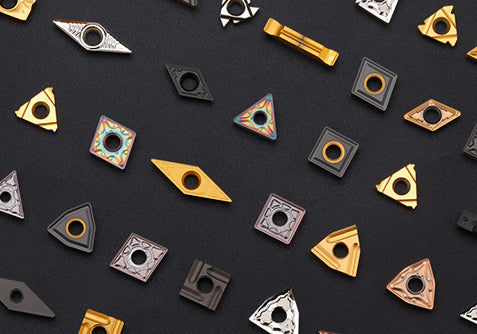
Elevating Precision: A Comprehensive Guide to Insert Coatings of CNC Inserts
Share
Introduction:
In the realm of CNC (Computer Numerical Control) machining, where precision reigns supreme and efficiency is paramount, insert coatings emerge as silent heroes, enhancing tool life, improving surface finish quality, and elevating machining performance to new heights. These specialized coatings, meticulously applied to CNC inserts, play a pivotal role in mitigating wear, reducing friction, and optimizing chip evacuation. In this comprehensive guide, we delve deep into the world of insert coatings, unraveling their intricacies, advantages, and applications in the dynamic landscape of modern machining.
Understanding CNC Inserts:
Before delving into the intricacies of insert coatings, it's essential to grasp the fundamental role CNC inserts play in machining. CNC inserts, also known as cutting inserts or tool inserts, are replaceable cutting tips meticulously crafted for CNC machining operations. They come in various shapes, sizes, and materials, each tailored to specific machining applications and requirements.
Unveiling Insert Coatings:
Insert coatings represent a critical aspect of CNC inserts, designed to enhance tool performance and longevity in demanding machining environments. These specialized coatings are applied to the surface of CNC inserts through advanced coating processes, such as physical vapor deposition (PVD) or chemical vapor deposition (CVD). Let's explore the different types of insert coatings and uncover their unique characteristics, advantages, and applications.
1. Titanium Nitride (TiN) Coating:
- Overview: Titanium nitride coating is one of the most widely used coatings for CNC inserts, known for its exceptional hardness and wear resistance.
- Characteristics: TiN coating provides a golden-yellow appearance and offers excellent adhesion to carbide substrates, reducing friction and improving chip flow.
- Advantages: TiN-coated inserts exhibit extended tool life, reduced cutting forces, and enhanced surface finish quality, making them suitable for a wide range of machining applications.
- Applications: TiN-coated inserts are commonly used in turning, milling, drilling, and threading operations across various materials, including steels, stainless steels, and cast irons.
2. Titanium Carbonitride (TiCN) Coating:
- Overview: Titanium carbonitride coating combines the hardness of titanium nitride with the lubricity of titanium carbide, offering improved performance in high-speed machining applications.
- Characteristics: TiCN coating provides a dark gray appearance and offers excellent wear resistance and thermal stability, reducing built-up edge and improving chip evacuation.
- Advantages: TiCN-coated inserts exhibit enhanced performance in high-speed and high-temperature machining conditions, resulting in longer tool life and improved productivity.
- Applications: TiCN-coated inserts are commonly used in milling, drilling, and threading operations, particularly in aerospace, automotive, and die/mold industries.
3. Aluminum Titanium Nitride (AlTiN) Coating:
- Overview: Aluminum titanium nitride coating combines the hardness of titanium nitride with the heat resistance of aluminum oxide, offering superior performance in high-temperature machining applications.
- Characteristics: AlTiN coating provides a dark purple or black appearance and offers excellent oxidation resistance and thermal insulation, reducing cutting temperatures and extending tool life.
- Advantages: AlTiN-coated inserts exhibit enhanced performance in machining heat-resistant alloys, stainless steels, and exotic materials, resulting in improved productivity and cost savings.
- Applications: AlTiN-coated inserts are commonly used in aerospace, automotive, and medical industries for milling, drilling, and threading operations where high-temperature stability is essential.
4. Diamond-Like Carbon (DLC) Coating:
- Overview: Diamond-like carbon coating is a thin film of amorphous carbon with diamond-like properties, including exceptional hardness and low friction.
- Characteristics: DLC coating provides a dark gray or black appearance and offers excellent wear resistance, low friction, and chemical inertness, reducing tool wear and adhesive tool-chip interactions.
- Advantages: DLC-coated inserts exhibit extended tool life, improved surface finish quality, and reduced cutting forces, making them suitable for machining abrasive materials and high-precision applications.
- Applications: DLC-coated inserts are commonly used in aerospace, automotive, and medical industries for milling, drilling, and turning operations, as well as in micro-machining and high-precision applications.
5. Chromium Nitride (CrN) Coating:
- Overview: Chromium nitride coating is a hard ceramic coating known for its excellent wear resistance and thermal stability.
- Characteristics: CrN coating provides a silver or metallic gray appearance and offers high hardness, oxidation resistance, and thermal insulation, reducing cutting temperatures and tool wear.
- Advantages: CrN-coated inserts exhibit extended tool life, improved surface finish quality, and enhanced wear resistance, making them suitable for machining hardened steels, stainless steels, and abrasive materials.
- Applications: CrN-coated inserts are commonly used in die/mold, automotive, and general engineering industries for milling, drilling, and threading operations where high wear resistance and thermal stability are essential.




